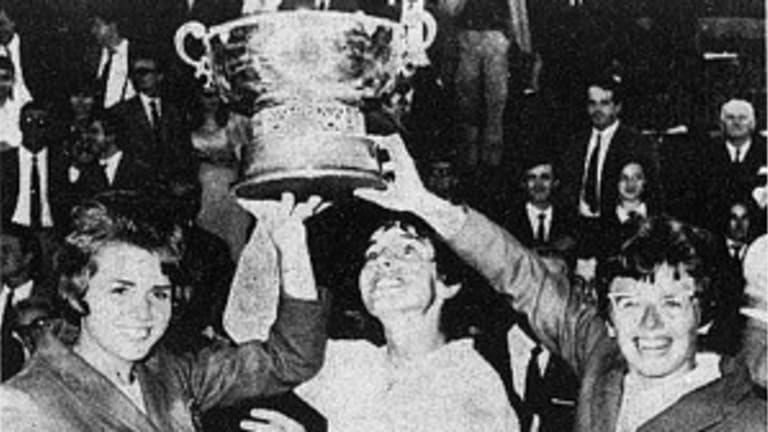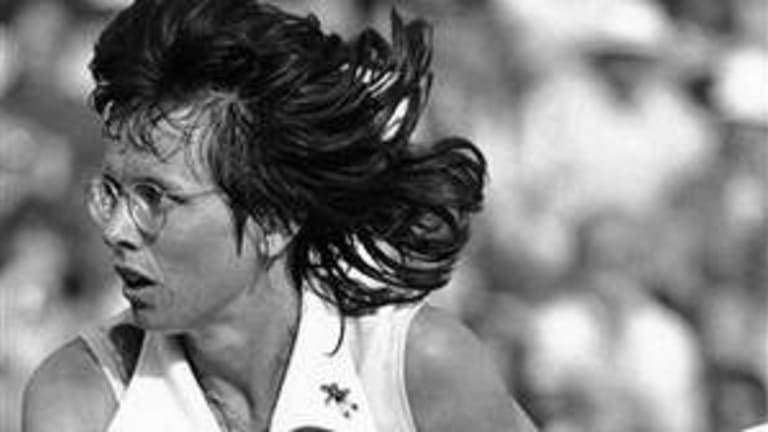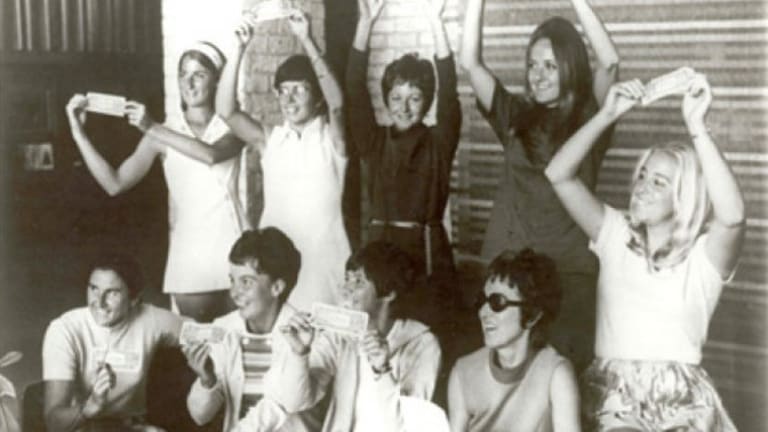Women's History Month: In 1970, the Original 9 starts a women's tour
By Steve Tignor Mar 04, 2021Social
Billie Jean King pays a visit to Sesame Street to celebrate International Women's Day
By Baseline Staff Mar 09, 2024Social
WATCH: ATP players in Rotterdam dish on who they love most on tour for Valentine's Day
By Baseline Staff Feb 14, 2024Style Points
Serena Williams wears black to introduce Green Day, her “literally favorite band of all time”
By Stephanie Livaudais Feb 06, 2024Lifestyle
Rafael Nadal’s Roland Garros winning racquet nets $118K at auction
By Liya Davidov Jan 30, 2024Lifestyle
One of Rafael Nadal’s Roland Garros winning racquets is up for auction
By Liya Davidov Jan 16, 2024Social
Billie Jean King drops puck to start Professional Women's Hockey League
By Ed McGrogan Jan 02, 2024Pop Culture
Coco Gauff, Billie Jean King, Serena and Venus Williams land in Google's '25 Years of Search'
By Baseline Staff Dec 17, 2023Social
Billie Jean King toasts '80 years young' on milestone birthday
By Baseline Staff Nov 22, 2023Social
GALLERY: Good vibes all around at BJK Cup Finals welcome reception, team photo shoots
By Baseline Staff Nov 06, 2023Women's History Month: In 1970, the Original 9 starts a women's tour
Pioneers Billie Jean King, Gladys Heldman and the rest of the Houston 9 laid the groundwork for the WTA.
Published Mar 04, 2021
Advertising
Throughout Women's History Month, TENNIS.com will be highlighting some of the most significant achievements and moments that make our sport what it is today.
All roads lead to Rome, people were once told. As far as the history of women’s professional tennis goes, you might say the reverse is true: All roads lead away from the Foro Italico.
By the time the world’s best men and women pros gathered there for the 1970 Italian Open, the brave new Open era was two years old. It had, as promised, begun to pay dividends for the top male players. Their prize money was handed to them above the table rather than beneath it, as it had been in the old shamateur days. And it was increasing. The previous year, Rod Laver had become the first player to earn more than $100,000 in a season.
The same could not, however, be said for the women, a fact that was made abundantly clear in Rome each spring. After watching a ladies’ final at the Foro that was scheduled before noon and played in an amphitheater where marble statues outnumbered live humans, Bud Collins concluded that “women’s tennis in Italy had the status of breakfast: something to be gotten out of the way early and fast, before the day’s consequential business began.”
The winner of the women’s final in Rome in 1970, Billie Jean King, had long suspected that amateur officials doled out more under-the-table expense money to the men than they did to the women. Now that the players’ compensation was public knowledge, her colleagues’ second-class status could be read, painfully, in the numbers. That year Italian officials paid the men’s champion, Ilie Nastase, $3,500 for his work, while King walked away with 600 bucks. Billie Jean said she realized at that point “we’d get nowhere at the mercy of the men who ran the federations.”
It didn’t take long for her epiphany to be confirmed. That summer the Pacific Southwest Open announced that it would offer $12,500 to the men, and $1,500 to the women—a “feudalistic ratio,” in Collins’ words. Despite protests, tournament director Jack Kramer didn't budge; he had fought for player rights his entire career, but he believed, as many in the game still believed at the time, that fans would only pay money to see the men play.

Women's History Month: In 1970, the Original 9 starts a women's tour
Advertising
Yet on the other side of the country, there was one tennis lover who did not believe this. Since founding World Tennis magazine in 1953, Gladys Heldman had used its pages to push relentlessly for, in the words of her fellow writer David Gray, “freedom, open tennis, democracy, and common sense,” in her sport. World Tennis “set off editorials like exploding fireworks,” Gray wrote. (At right: Carole Caldwell Graebner, Julie Heldman and Billie Jean King at the 1966 Federations Cup.)
Heldman, a 48-year-old native of New York City, was the intelligent, irreverent daughter of a judge, and the wife of a Shell Oil research scientist. She had entered Stanford University after receiving a letter of recommendation from family friend Herbert Hoover, and graduated Phi Beta Kappa in three years. As Doug Robson wrote in Tennis magazine in 2008, Heldman put her money where her words were in 1962 when she put up $1,800, and convinced nine of her tennis-fan friends to do the same, to fly 85 high-level European players to New York to play in the U.S. Championships (now the US Open).
“At that point,” according to Robson, “fewer and fewer foreign amateur players were making the costly overseas trip, which was hurting the quality of the event.” With Heldman’s imports, the quality immediately went up, as did the ticket sales. The tournament grossed $100,000 more than it had the previous year. It was, in a way, the start of the modern, jet-powered tennis circuit that we take for granted today.
“Heldman anticipated that the jet airplane would play a vital role in any world tennis tour,” wrote historian E. Digby Baltzell of her risky master stroke of ’62. “I happened to go out to Forest Hills on opening day that year and incredulously watched the first truly international tennis tournament I had ever seen.”
Eight years later, Heldman would be called on to take an even riskier step in the name of tennis progress. King and her doubles partner Rosie Casals enlisted her help in their fight with Kramer. Heldman was in the process of moving to Houston, so she floated the idea of staging an eight-player women’s professional tournament there, the same week as the Pacific Southwest. Bleachers were soon constructed at the Houston Racquet Club, and tickets were sold. But Kramer, with support from former USLTA president Bob Kelleher, protested, and the USLTA threatened to suspend any woman who entered the Houston event. In those days of top-down federation control, that meant they could be banned from playing the Grand Slams, and from all international team events.

Women's History Month: In 1970, the Original 9 starts a women's tour
Advertising
Suddenly, just two years after crossing the threshold into Open tennis, the sport found itself at another historic crossroads between its traditionalist past and its professional future. Back in ’68, Kramer and Kelleher had been insurgent forces against the amateur establishment; now they had become obstacles to further progress. Lined up on the other side of the divide were the new rebels: King, Heldman, and Heldman’s old family friend Joe Cullman, who was also the chairman of Philip Morris. Cullman and Heldman, both Jewish, had played tennis together at the Century Country Club in Westchester County. But Cullman, despite his prominence—his grandfather had owned Benson & Hedges—had felt the sting of rejection at other, WASP-only clubs on the east coast.
“It would have been normal with the connections I’ve got,” Cullman once said, “to have been asked to join one of those clubs, but I wasn’t. I survived very well without it. But I can recall it. It didn’t go unnoticed.”
“This blanket, club anti-Semitism,” Baltzell wrote, “probably led [Heldman and Cullman] to take the lead, in the last decade of amateur tennis, in eventually bringing about the Open era.”
Cullman, with no stake in the game’s past, was happy to make Philip Morris a sponsor of the first U.S. Open in 1968. He was just as happy, two years later, to get his company in on the ground floor of the women’s pro game. He contributed $2,500 to his old friend Gladys’ Houston event, in exchange for naming it after a line of cigarettes that his company had begun marketing to women two years earlier: Virginia Slims.
“When Madison Avenue dreamed up the slogan to go with the launch of the brand—“You’ve come a long way, baby”—they had no idea how apt it would be, or how far Virginia Slims and women tennis professionals would take [the] sport,” British journalist Richard Evans wrote.
In a sense, the Open era meant opening tennis to the marketplace, in particular the American marketplace, with all of the compromises and pitfalls that entailed. The tour would be criticized over the years for promoting cigarettes, but Cullman was the right sponsor for the moment. Heldman even named two of her cats Virginia and Slim.
Advertising
The establishment, however, wasn’t ready to let go. The USLTA and ILTF were only willing to give the tournament permission to run an amateur event, which meant that the prize money would stay under the table. As Robson wrote, “The organization was trying to maintain control of the players in the pro era,” even if it meant paying them in secret.
Heldman, her lawyer’s genes kicking in, crafted an ingenious way out of the impasse. She signed the nine players who were willing to risk suspension to a nominal $1 “personal service” contract with World Tennis. This made them “contract pros,” which in turn made Houston an all-professional event, which in turn took it out of the USLTA’s jurisdiction. The USLTA went ahead and suspended the players, but the tournament went on as planned. At the same time, Heldman set up two more events and extended her players’ contracts.
In Houston, King, Casals, Kristy Pigeon, Nancy Richey, Val Ziegenfuss, Judy Tegart Dalton, Kerry Melville Reid and Peaches Bartkowicz, posed for a now-iconic photograph while waving dollar bills. With late-entrant Julie Heldman, they became known as the Houston 9. Julie’s mother, Gladys, posed with them in her customary sunglasses. Women tennis players, it seemed, could be pros. They could even be outlaws.

Women's History Month: In 1970, the Original 9 starts a women's tour
Advertising
“It was a real risk,” King said later. “We would have looked pretty silly if we had failed. If nobody had come to see us play we would have been dead. But they did come. The timing was right.”
The Slims tour—Heldman nicknamed it “Women’s Lob, Featuring the Little Broads”—had been launched, and despite the early skepticism, fans paid to see it. A niche, it seemed, had been filled, and tennis had crossed another threshold. The following year, King became the first woman to pass the $100,000 mark in prize money.
“They were pioneers and publicity agents and true professionals,” Evans wrote of the first group of women pros, “and because they had such a barrier of prejudice to break down, they were always so much better at selling the game of tennis than the men.”
More than 50 years later, if you jet around the world on the tennis circuit, you’ll find the women making the same money as their male counterparts at all of the Grand Slams. You’ll find them packing the arena at the women’s-only WTA Finals. And if you follow that road through the air all the way back to Rome, you’ll find them playing alongside the men, in front of the same teeming crowds, at the Foro Italico.